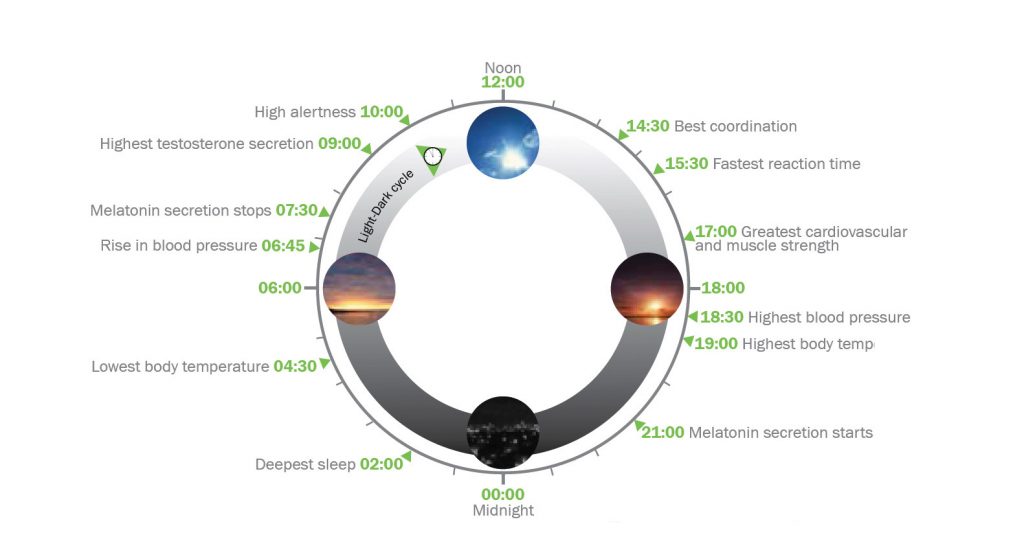By now, we all know that low access to daylight can be detrimental to our health. Eye strain, exhaustion, and weakening mental health are all issues that share a root cause in poor access to light.
But what if the implications of access to daylight went beyond wellness and energy savings, and we could prove it was inextricably linked to increases in productivity? If we were able to tell hour-by-hour (even minute-by-minute) how optimized a person’s mind and body is under specific lighting conditions, we would be able to leverage that information toward creating a workplace that goes beyond simply housing business activity, and actually improves the quality of work being done.
In fact, we already can. It’s called Circadian Lighting: a lighting system designed to tap into the proven cycles our bodies’ follow each day, based on the position, angle, and color of natural sunlight at any given time. These cycles are known to lighting designers and medical researchers as “circadian rhythms,” and a circadian lighting system is tailored specifically to maximize our functionality.

For example, in a traditional office space we tend to either have electric lighting we can turn on or off, but there is rarely a distinction in the color of that light, or its brightness (think: rows of fluorescents hung uniformly below a white dropped ceiling… your eyes may be hurting already). This works against occupants’ naturally occurring circadian rhythms and can cause dramatic decreases in overall wellness and productivity. What lighting designers seek to do with a circadian lighting system is mimic the behavior of the sun and incorporate it into the everyday work environment to benefit occupants by creating a comfortable environment and actually increasing productivity. This can be achieved with a few methods that we’ll explore in this article, including introducing natural light into areas through architectural elements and by mimicking the solar sequence through tunable LED lighting.
“Recent studies of office worker performance show that those with the best views of natural light perform better on tests of mental function and memory recall.”
When we examine the pattern of the sun through its 24-hour cycle, we notice that the light it emits more complex than light and dark. The color and intensity of sunlight changes throughout the day: Warm amber light at sunrise slowly changes into a cooler, brighter light during the day, before warming back into an amber light at sunset. Human vision follows this cycle throughout the day. The eye consists of cells that act as photoreceptors, called rods and cones, which play a vital role. Cones sense changes in color and bright light, while rods sense changes in low light levels. The eye sends these signals to the brain to trigger the release of serotonin (the body’s natural antidepressant) during the day and melatonin (a hormone effecting sleep) at night. This is what creates our circadian rhythm and promotes our mental and physical health, our mood, and our energy.

The Benefits of Circadian Lighting
As noted earlier, lighting designers are able to leverage data on how the average human body reacts to create a lighting system that understands what kind of light an occupant needs to perform at optimum levels on an hour-to-hour (or as we see in the image above, a minute-to-minute) basis. Just like with a healthy diet, if we feed the body what it needs, it will perform better.
The benefits of human-centric circadian lighting design include:
- Increased alertness in the morning
- Productivity and concentration improvements
- Improved mood
- Reduced hyperactivity
- Reduction in errors and accidents
- Faster cognitive processing
- Improved sleep
Recent studies of office worker performance have shown that those with the best possible view of natural light performed between 10% and 25%1 better on tests of mental function and memory recall. On the other hand, those with poor views or no view at all (think high cubical partitions, heavy glare, basement offices etc.), reported increases in fatigue and decreases in overall speed of performance. These variables can be controlled with circadian lighting design. Incorporating daylighting in the architecture can boost not just the performance of a building, but of those who occupy it as well.
Circadian lighting has shown to have useful applications in the healthcare industry as well, benefiting patients and institutions alike by actually decreasing average length of patient stays. A recent study published in Building and Environment reported findings that patients with direct access to morning light were seeing their stays shortened by anywhere from 16% to 41%2.

How it’s done
Existing technologies now allow us to recreate the sun’s daily path to help directly manage occupants’ circadian rhythms, particular in spaces that have poor access to natural light. LED light fixtures can mimic the solar color shift with color changing technology and DALI color changing controls, creating the same health benefits we see from natural daylight. For LED circadian lighting to work, a controls system must be used that is setup to handle the job, and at this point in time, that is the biggest cost. Numerous manufactures have their own system designed already and it can be done using a variety of products. From imitation skylights like Arbor Light and Coelux, to downlights like those made available by Ketra, the base models already exist. A full cycle of human-centric lighting has already become a reality for workplaces and healthcare facilities across the United States, and they are seeing the productivity benefits in real time.
That being said, natural light has the most direct effect on our circadian rhythms. And harnessing it for our interior spaces is the most effective way to optimize its effects. However, this means more than just allowing light into a space. Giant windows can often overheat those nearby in afternoon sun, do little to deflect glare, and leave much of the space totally unaffected. Proper daylighting involves controlling light and getting as much effective illuminance to target areas as possible, while minimizing heat gain and glare. Architectural design elements like light shelves and louvers can bring more light into the interior of a building when added to glazing. They can also direct the light deeper into a space. Exterior overhangs and vertical fins on the glazing walls of a building can mitigate glare and heat gain.
At GLUMAC, we believe circadian lighting is the future of lighting design. To learn more about our work, email our Lighting Studio at [email protected].
Click here to read the full Circadian Lighting Green Paper.

